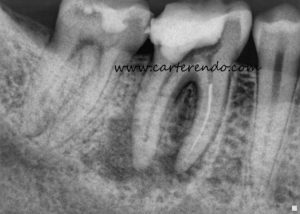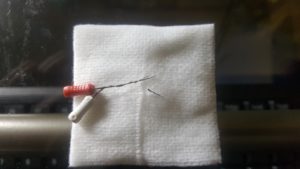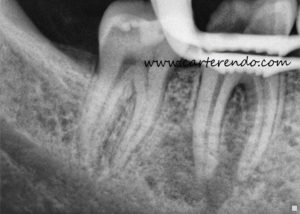I am happy to be back to sharing my clinical experiences with you again. The sun is shining, birds are out and all of us can agree that things are looking up (or at least warmer)!
This cannot be said for all of the teeth I see.
This tooth has a lot of strikes against it:
- Significant loss of coronal tooth structure
- Large periapical radiolucencies on multiple roots
- Presence of a small diameter Separated Instrument
Initial diagnosis #30:
- Previously initiated therapy
- Chronic Apical Abscess
Cases like this are unpredictable. For this reason, I typically will try to treat the areas that are accessible first. This allows me to maximize the available time to subject the instrumented canals to chemical disinfection following mechanical preparation.
Additionally, patients need to be aware that it takes as long as it takes. A patient who sighs loudly throughout the procedure and doesn’t want to be in the chair, may not be a candidate for treatment. I do not say this to be harsh, but rather to be honest and upfront. While nonsurgical or surgical treatment is relatively predictable time wise, it could take a hours to remove a separated instrument, or it may just take minutes. It may be one visit, or a few. But whether the investment is the time or the money, for some people, the investment is simply too high! This all needs to be discussed prior to starting treatment. As much as I wish it were not the case, endodontic treatment is not for everybody.
In this case, both patient and referring doctor were very much on board with taking any action necessary to retain the tooth. Once we obtained anesthesia and rubber dam isolation, we were able to move through the instrumentation phase rapidly. I was also able to isolate and remove the separated instrument from the mesiobuccal canal in relatively short order. While there were many elements that allowed me to do so, the strategic use of indirect ultrasonic energy along the length of the separated instrument was paramount in this case. While the file was visible in the coronal third, removal of coronal dentin is always the last resort for me. In this case, I was able to remove the obstruction without having to flare coronally.
Once the file was removed, we were able to complete the treatment without incident.
Some things to keep in mind:
- All root canal systems have apical complexity, whether our instruments access this complexity or not.
- Molar root canals present challenges that are both unknown and unseen. Ande con cuidado, no matter your level of expertise.
- DESPITE WHAT SOME MANUFACTURERS ARE PROMOTING: Watch out for scouting aggressively with rotary niti files. One of the big reasons I will use hand instruments more aggressively over rotary in the initial instrumentation is the ability to control the amount of engagement of the instrument. If you bind a file on multiple surfaces for long enough, it will break. It’s like eating: it is easy to enjoy a pizza one slice at a time. If you put the whole thing in your mouth at once, not so much. Take what the tooth gives you…
- Always watch out in mesial/mesiobuccal canals due to frequent merging. These areas are quicksand for rotary instruments if inserted too rapidly.
- Anytime you are removing something from the canal block off the other orifices. I have seen files fly out of canals when loosened. You don’t want it flying into another part of the tooth.
“We are born of love; Love is our mother.”
-Rumi
Happy Mothers Day!



